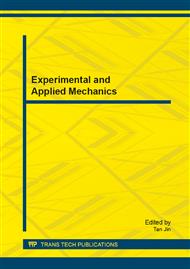[1]
Zukas J A. Impact Dynamics. New York: John Wiley, 1982: 155–156.
Google Scholar
[2]
Ipson T W, Recht R F. Ballistic perforation by fragments of arbitrary shape, NWC TP 5927. California: Denver Research Institute, (1977).
Google Scholar
[3]
Wingrove A L. The influence of projectile geometry on adiabatic shear and target failure. Metallurgy Transaction A, 1973, 4: 1829–1833.
DOI: 10.1007/bf02665409
Google Scholar
[4]
Othe S, Yoshizawa H, Chiba N, et al. Impact strength of steel plates struck by projectiles. Bulletin JSME 1982, 25(205): 1226–1231.
DOI: 10.1299/jsme1958.25.1226
Google Scholar
[5]
Wilkins M L. Mechanics of penetration and perforation. International Journal of Engineering Sciences, 1978, 16: 793–807.
Google Scholar
[6]
Børvik T, Langseth M, Hopperstad O S, et al. Ballistic penetration of steel plates. International Journal of Impact Engineering, 1999, 22(9–10): 855–887.
DOI: 10.1016/s0734-743x(99)00011-1
Google Scholar
[7]
Børvik T, Langseth M, Hopperstad OS, et al. Perforation of 12 mm thick steel plates by 20 mm diameter projectiles with flat, hemispherical and conical noses, Part I: experimental study. International Journal of Impact Engineering, 2002, 27: 19–35.
DOI: 10.1016/s0734-743x(01)00034-3
Google Scholar
[8]
Børvik T, Hopperstad O S, Dey S, et al. Strength and ductility of Weldox 460 E steel at high strain rates, elevated temperatures and various stress triaxialities. Engineering Fractures Mechanics, 2005, 72: 1071–1087.
DOI: 10.1016/j.engfracmech.2004.07.007
Google Scholar
[9]
Børvik T, Hopperstad O S, Langseth M, et al. Effect of target thickness in blunt projectile penetration of Weldox 460 E steel plates. International Journal of Impact Engineering, 2003, 28: 413–464.
DOI: 10.1016/s0734-743x(02)00072-6
Google Scholar
[10]
Dey S, Børvik T, Hopperstad O S, et al. The effect of target strength on the perforation of steel plates using three different projectile nose shapes. International Journal of Impact Engineering, 2004, 30(8 - 9): 1005–1038.
DOI: 10.1016/j.ijimpeng.2004.06.004
Google Scholar


